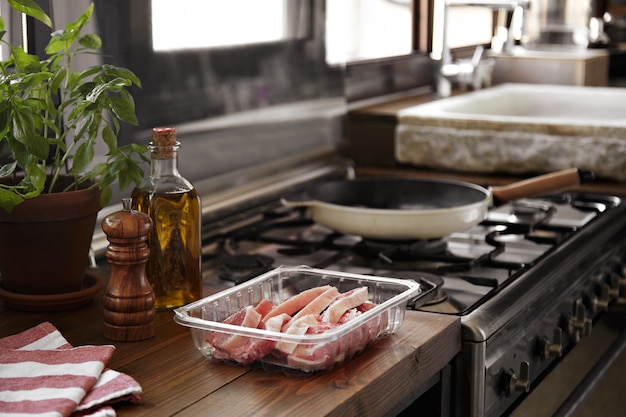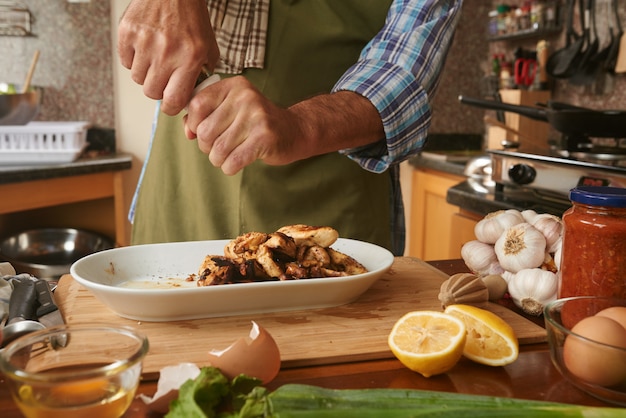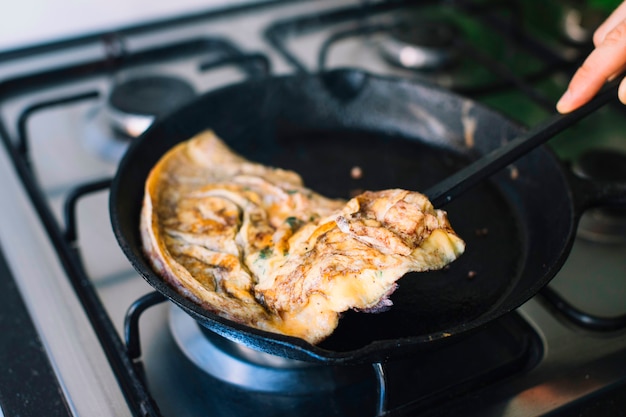Ah, pot roast. It's a dish that conjures up images of cosy winter nights, crackling fireplaces, and the intoxicating aroma of slow-cooked meat filling the air. But let's face it, achieving that melt-in-your-mouth, flavour-packed pot roast can feel like a culinary mystery. Fear not, dear reader, for this guide is here to unravel the secrets to oven-baked pot roast perfection. We'll journey through the steps, from choosing the right cut to perfecting the timing, leaving you with a masterpiece that will have your family and friends swooning.
(Part 1) Choosing the Right Cut: The Foundation of a Stellar Pot Roast

Let's get this out of the way: a truly remarkable pot roast starts with the right cut of meat. It's the cornerstone of your culinary adventure. Pick the wrong cut, and you'll be left with a chewy, disappointing dish. But fret not, we're going to navigate this crucial step together. The classic choice for pot roast is, without a doubt, the chuck roast. It's a cut brimming with flavour, but it requires a little patience and gentle coaxing to reveal its tender heart. It boasts a generous amount of marbling, which ensures juicy results and adds a touch of richness to the flavour profile.
Understanding the Cuts and Their Characteristics: A Guide to Your perfect pot roast
Before you head to the butcher, let's delve into the world of pot roast cuts and understand what makes each one unique. Here's a rundown of popular choices and their characteristics:
| Cut | Characteristics | Ideal cooking time |
|---|---|---|
| Chuck Roast | Full of flavour, marbled with fat, tenderizes with long cooking | 3-4 hours |
| Brisket | Rich, fatty, requires long cooking, ideal for pulled beef | 4-6 hours |
| Round Roast | Lean, needs long cooking to become tender, often used for roasts or sliced beef | 3-4 hours |
| Shoulder Roast | Similar to chuck roast, but often less marbled, budget-friendly option | 3-4 hours |
When choosing your cut, consider a few factors: the size of your roast, the fat content, and the flavour profile you're aiming for. A larger roast will feed a crowd, while a smaller one is perfect for a cosy dinner. A high-fat cut will be more tender and juicy but might not be the ideal choice if you're mindful of cholesterol. And finally, consider the flavour you desire. A chuck roast will offer a robust flavour, while a round roast will be milder.
(Part 2) Preparing the Pot Roast: Building a Flavorful Foundation

So, you've found your perfect cut. Now it's time to unleash your culinary creativity and prepare it for its transformation. This stage is all about creating a foundation for rich flavour. It's like adding the essential ingredients to a masterpiece before it takes shape.
Seasoning with Love: A Symphony of Flavours
Seasoning is your opportunity to paint your pot roast with flavour. Don't be shy! Experiment and create your own unique blend. A classic approach involves a simple combination of salt, pepper, and garlic powder. But feel free to add a touch of paprika, onion powder, thyme, rosemary, or even a dash of cayenne pepper for a little heat. Remember, the goal is to enhance the natural flavours of the meat, not to overpower them.
Searing the Pot Roast: A Crispy Embrace
Searing is an essential step that adds depth and complexity to your pot roast. Think of it as a warm embrace that creates a delicious crust on the outside while locking in those precious juices. Heat up your trusty cast iron skillet or a heavy-bottomed pan, add a drizzle of oil, and sear the roast on all sides. This creates a foundation for a truly irresistible pot roast experience.
(Part 3) The Oven: Your Partner in Pot Roast Perfection

We've arrived at the heart of the matter, the oven! This is where the magic unfolds, where your pot roast will be transformed from a simple piece of meat into a tender, flavour-packed masterpiece. We'll navigate the world of oven cooking, exploring the techniques and tricks that will elevate your pot roast to new heights.
Choosing the Right Oven Temperature: The Key to Gentle Transformation
The oven temperature plays a crucial role in achieving that perfect pot roast. For a classic pot roast, you'll typically cook it at a low temperature, around 325°F (160°C). This slow, gentle cooking method allows the meat to break down, becoming incredibly tender and juicy. Imagine it as a slow dance, where time and patience are the key ingredients for a beautiful outcome.
Creating the Perfect Pot Roast Environment: A Moist Embrace
The secret to a truly delectable pot roast lies in creating a moist environment that allows the meat to cook evenly and tenderize without drying out. There are two main methods to achieve this:
- Braising: This technique involves browning the pot roast, then adding liquid - like beef broth, red wine, or even water - to the pan. Cover the pan and cook it in the oven at a low temperature for several hours. The liquid keeps the meat moist and adds depth of flavour as it reduces and concentrates. Think of it as a luxurious bath for your pot roast.
- Roasting with a Lid: This method is similar to braising but skips the browning step. Place the roast in a roasting pan, cover it tightly with a lid, and bake it in the oven. This traps moisture and steams the meat, resulting in an incredibly tender and juicy roast.
The Art of Liquid Choice: Elevating Your Pot Roast with Flavor
Now, let's talk about the liquid you'll be using. This is where you can inject your personality into your pot roast, adding a touch of your own culinary magic. Classic beef broth or stock is a reliable choice, offering a rich, savory base. Red wine adds depth and complexity, while beer can bring a hint of malty sweetness. Don't be afraid to experiment! I once added a splash of apple cider vinegar to my pot roast, and the hint of tanginess was a revelation.
(Part 4) Mastering the Timing: The Art of Knowing When It's Done
Now, it's time to talk about timing. Understanding the factors that affect cooking time and knowing when your pot roast is ready is crucial. While there are no rigid rules, there are a few key points to keep in mind.
Understanding the Factors That Affect Cooking Time: A Guide to Time Management
The size of the roast is the most obvious factor. A larger roast will take longer than a smaller one. The cut of meat also plays a role. A chuck roast, with its higher connective tissue content, requires more time to break down than a leaner round roast. And of course, your chosen oven temperature has a significant impact on the cooking time.
The meat thermometer: Your Reliable Companion in the Kitchen
The best way to ensure your pot roast is cooked to perfection is to use a meat thermometer. A safe internal temperature for pot roast is 145°F (63°C). This means the meat is cooked through and safe to eat. Once the roast reaches this temperature, it's ready to be removed from the oven.
Resting the Pot Roast: The Secret to Tenderness
Once your pot roast is cooked, it's essential to let it rest before carving. This allows the juices to redistribute throughout the meat, resulting in a more tender and juicy final product. I usually let mine rest for at least 15 minutes, covered with foil, before slicing it up. The patience is worth it, I promise.
(Part 5) The All-Important Gravy: A Finishing Touch That Makes All the Difference
Ah, gravy! The star of the show, in my opinion. It takes your pot roast from good to glorious, adding a silky smooth, flavour-packed sauce that elevates every bite. Here's how to create a gravy that will leave your guests begging for seconds.
Collecting the Flavorful Pan Juices: The Heart of a Delicious Gravy
Once your pot roast is cooked and rested, remove it from the pan and set it aside. The pan will be filled with delicious, flavourful juices, which will form the base of your gravy. Now, it's important to skim off any excess fat that has settled on top. This will prevent your gravy from being too greasy and allow the flavours to shine through.
The Power of Thickening: Creating a Deliciously Smooth Gravy
There are a few ways to thicken your gravy. My favorite is using a cornstarch slurry. Simply whisk together a tablespoon of cornstarch with a couple of tablespoons of cold water. Then, slowly whisk the slurry into the pan juices. Bring the mixture to a simmer and cook, stirring constantly, until the gravy has thickened to your liking. If you prefer a more traditional approach, you can use a roux, which is made by cooking butter and flour together. Both methods will yield a delicious and satisfying gravy that will perfectly complement your pot roast.
(Part 6) Serving Your Masterpiece: A Feast for the Senses
Finally, the moment of truth! Your pot roast is cooked to perfection, the gravy is silky smooth, and it's time to assemble your culinary masterpiece. Take a deep breath, savour the aroma, and get ready to taste the fruits of your labour. This is a moment to be savored, a celebration of your culinary journey.
Creating a Feast: Sides that Complement Your Pot Roast
A pot roast deserves an entourage of equally delicious side dishes. Think creamy mashed potatoes, comforting polenta, or a refreshing green salad. You can also add some caramelized onions, roasted root vegetables, or even a side of bread for soaking up that divine gravy. These are just suggestions, of course. Feel free to unleash your creativity and assemble a spread that reflects your own taste and preferences.
The Art of Carving: A Celebration of Tenderness
Now for the grand finale. The moment of truth. It's time to carve your pot roast. Take a sharp knife and cut the meat against the grain. This will ensure that each slice is tender and easy to chew. You can slice the meat thinly or in thicker pieces, depending on your preference. I find that slicing it thinly allows for even more of that delicious gravy to coat each slice.
(Part 7) Embracing Leftovers: The Art of Reheating and Reimagining
Don't be afraid of leftovers! In my humble opinion, pot roast actually gets even better the next day. The flavours have time to meld, and the meat becomes even more tender. Here are a few ideas for how to use up those delicious leftovers and turn them into a new culinary adventure.
Reheating Your Pot Roast: Maintaining the Tenderness and Flavour
If you're simply looking to reheat your pot roast, you can do so in the oven, in a skillet on the stovetop, or even in the microwave. Just make sure to heat it through thoroughly and serve it with your favourite sides. I often find that reheating my pot roast in the oven, covered with foil, helps to keep it moist and tender.
Creative Leftover Ideas: Transforming Leftovers into Delicious Delights
Leftover pot roast is a culinary blank canvas, ready for your creative touch. You can use it to make delicious sandwiches, soups, stews, or even pot pie. I love making pot roast sandwiches with a generous dollop of horseradish sauce and a slice of sharp cheddar cheese on toasted bread. It's a truly satisfying treat.
(Part 8) FAQs: Your Pot Roast Questions Answered
Here are a few common questions that often come up when it comes to pot roast:
1. Can I use a slow cooker for pot roast?
Absolutely! A slow cooker is a fantastic option for cooking pot roast. Simply sear the roast as described earlier, then transfer it to your slow cooker with your chosen liquid. Cook on low for 6-8 hours or on high for 3-4 hours. The slow cooker will do the hard work for you, resulting in a tender, melt-in-your-mouth pot roast. It's a great choice for busy days or those times when you want to come home to a delicious, ready-to-eat meal.
2. What if my pot roast is too tough?
Don't despair! If your pot roast is too tough, there are a few things you can do. First, make sure you're using a cut of meat that's suitable for pot roasting. Second, cook it for a longer time. Third, try adding a little more liquid to the pan during cooking. And finally, don't be afraid to shred the meat if it's still a bit tough. This will make it easier to eat and will also make it perfect for dishes like sandwiches or pot pie. Remember, even with a slight misstep, there's always a way to salvage your pot roast and turn it into something delicious.
3. Can I freeze pot roast?
Yes, you can freeze pot roast. Simply wrap the cooked meat tightly in plastic wrap, then place it in a freezer-safe bag. You can freeze it for up to 3 months. To thaw the pot roast, transfer it from the freezer to the refrigerator overnight. This is a great way to save time and have a delicious meal ready to go whenever you need it.
4. How can I make pot roast even more flavorful?
There are a few ways to boost the flavour of your pot roast. Try adding some aromatics to the pan, like onions, garlic, carrots, or celery. These will infuse the meat with deliciousness as they cook. You can also use a flavorful liquid like red wine, beer, or even a mix of different stocks. Don't be afraid to experiment with different seasonings and herbs to find what you like best.
5. How do I tell if my pot roast is done?
The best way to know if your pot roast is done is to use a meat thermometer. Insert the thermometer into the thickest part of the meat, making sure to avoid any bone. The internal temperature should be 145°F (63°C) for a safe and delicious pot roast. This is a foolproof method to ensure your pot roast is perfectly cooked and ready to enjoy.
So there you have it! Everything you need to know about cooking the perfect pot roast. From selecting the right cut to mastering the timing and creating a divine gravy, this guide has you covered. Now go forth and impress your family and friends with your culinary prowess!
Everyone is watching

Corn on the Cob: The Ultimate Guide to Perfectly Cooked Ears
Healthy MealsAh, corn on the cob. Just the name evokes images of sunny days, barbecues, and that sweet, juicy flavour that ...

Scallops: The Ultimate Guide to Perfect Cooking
Healthy MealsAh, scallops. Those delicate, sweet, and utterly delicious morsels of the sea. They hold a special place in my...

Spaghetti Squash: The Ultimate Guide to Cooking and Serving
Healthy MealsRemember that time you saw spaghetti squash at the supermarket, looking all bumpy and strange, and thought, "W...

Salmon Cooking Times: Perfect Guide for Every Recipe
Healthy MealsLet me tell you, cooking salmon is an art form. It's all about getting that perfect balance: juicy and tender,...

Ham Cooking Time: How Long to Bake, Smoke, or Boil a Delicious Ham
Healthy MealsAh, ham. It's a classic, isn't it? A real crowd-pleaser, especially around holidays. And when done right, it'...
